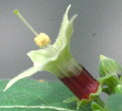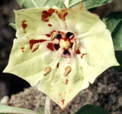




| Jaltomata (Solanaceae) of the lomas formations of Peru |
revised Feb 2022 |
Link to Jaltomata homepage |
The information on this page may be cited as a communication with both professor Thomas Mione, Central Connecticut State University, Biology Department, Copernicus Hall, 1615 Stanley Street, New Britain, CT 06050-4010, and Segundo Leiva G., Universidad Privada Antenor Orrego, Av. America Sur 3145, Casilla Postal 1075, Trujillo Peru. |
Literature Cited |
 |
 |
 |
 |
 |
Lomas formations are highly endemic plant communities occurring in near-shore locations of Peru and Chile where ocean fog provides sufficient moisture for the development of vegetation (nearly verbatim from Dillon 2005). "Each locality is an island of vegetation among a virtual ocean of arid desert, ..." (Dillon 2005). In the genus Jaltomata there are seven species that grow in this habitat.
|
Table of the Jaltomata of the Peruvian lomas:
J. quipuscoae |
|||||||
 |
 |
 |
 |
 |
|||
| Department | La Libertad |
Ancash |
Lima |
Arequipa |
Lima |
Lima |
Arequipa |
| habit | shrub |
shrub |
shrub |
shrub |
shrub |
herbaceous to suffrutescent |
herbaceous |
| Months in flower | August - October |
September, January |
September |
January, March |
July - October, January |
Late August, September & October in lomas; January through early April in Andes |
October in lomas; January & February in Andes |
| Red/Orange Nectar? | no |
no |
no |
no |
yes |
yes |
yes |
| green spots at based of corolla | yes |
yes |
no data |
yes |
no |
no |
yes |
| endemic to lomas? | yes |
yes |
yes |
yes |
yes |
no |
no |
| Known from a single locality? | yes |
yes |
yes |
yes |
no |
no |
no |
| deciduous leaves | yes |
leaves were present in January (Mione, Leiva & Yacher 631) |
no data
|
no data |
no |
no
|
no
|
Islands: All of the above species that grow exclusively in the lomas may be viewed as growing on virtual islands. Two additional Jaltomata species grow on oceanic islands, J. antillana (Greater Antilles) and J. werffii (Galápagos Islands). Deciduous: Jaltomata truxillana (Cerro Campana, Department La Libertad) is deciduous, dropping its leaves for the dry season. J. umbellata appears not to be deciduous: I visited a population at Reserva Nacional de Lachay in June of 2005 during a drought and plants had leaves. Endemism: Five of the seven species are endemic to the lomas; see table for details. |
Keys to the Jaltomata of the Peruvian lomas formations:
1. Floral nectar red/orange . . . . . . . . . . . . . . . . . . . . . . . . 2 1. Floral nectar transparent . . . . . . . . . . . . . . . . . . . . . . . . . . . . . . . . . . . . . . . . . . . 4 2. Corolla tubular, shrub . . . . . . . . . . . . . . . . . . . . . . . J. umbellata 2. Corolla very broadly campanulate, herbaceous or woody only at base . . . . 3 3. Lacking 10 green corolla spots . . . . . . . . . . . . . . . . . . . . . . . . . . . . . J. aspera 3. Having 10 green corolla spots . . . . . . . . . . . . . . . . . . . . . . . . . . . J. quipuscoae 4. Branches villous with gland-tipped hairs. . . . . . . . . . . J. hunzikeri 4. Branches essentially glabrous . . . . . 5 5. Filaments essentially glabrous . . . . J. atiquipa 5. Filaments villous along lower approximately half . . . . . . 6 the following couplet no longer works, given photos of J. lomana provided by S. L. G. 6. Stamens included (inside of corolla); corolla 5-lobed . . . . . . J. lomana 6. Stamens exserted; corolla 10-lobed . . . . . . . . . . . . . . . . . . . J. truxillana
1. Herbaceous but possibly woody at ground-level; corolla crateriform (very broadly campanulate); nectar red . . 2 1. Shrubs; corolla short-tubular or crateriform; nectar clear or red . . . . . . . . . . . . . . . 3 2. Lacking corolla spots, the corolla green-yellow or yellow-green . . . J. aspera 3. Corolla tubular, the tube at least 6.5 mm long; nectar red . . . . . . . . . . . . . . . J. umbellata 3. Corolla crateriform or tubular, the base of the corolla less than 6.5 mm long; lacking red nectar . . . . . . . . . . . 4 4. Corolla with blue ring in tube; young axes, petioles, peduncles, pedicels, and abaxial face of calyx villous J. hunzikeri 4. Corolla tube lacking blue ring; axes and leaves glabrous or nearly so . . . . . . . . . . . . . . . . . . . . . . 5 5. Slender part of filament (not the base) glabrous . . . . J. atiquipa 5. Slender part of filament (not the base) villous along approximately lower half . . . . . . . . . . . . . . . . 6 6. Corolla 5-lobed and white, the limb spreading (not planar); stamens included . . . . . . . . . . . . . . . J. lomana 6. Corolla 10-lobed, the limb lavender near tube, fading to white toward margin of limb, the limb planar; stamens exserted . . . . . J. truxillana |
Jaltomata lomana is correctly listed as part of the floristic diversity of Loma Mongón, Department Ancash (Leiva González, Zapata Cruz et al. 2008).
| Acknowledgements: Gregory J. Anderson and Gabriel Bernardello provided the environment conducive to the birth of this project. Michael Dillon has provided valuable information about the lomas habitat, in correspondence, copies of his published works and in presentations at meetings. I thank Arturo Granda and Graciela Vilcapoma for sending me herbarium specimens and the photo of J. aspera shown above. Victor Quipuscoa took the photo of J. quipuscoae shown above, at high elevation not in the lomas. Segundo Leiva illustrated J. lomana (shown in the table), took the photo of J. truxillana shown, and has the most amazing abilities during field work. Rene Chavez sent to Tilton Davis IV seeds of J. umbellata and T. Davis generously passed the seeds on to me. Leon Yacher was indispensable during fieldwork. |